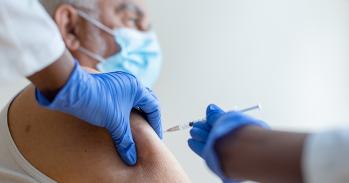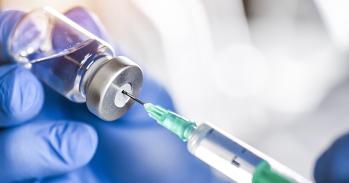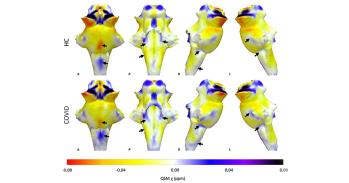
The Pfizer BioNTech vaccine BNT162b2 is likely to be effective against the B1.1.7 variant of SARS-CoV-2, even though its efficacy is modestly affected, say scientists at the University of Cambridge. However, when the E484K mutation – first seen in the South African variant – is added, it substantially increases the amount of antibody required to prevent infection.
The Pfizer BioNTech vaccine BNT162b2 is likely to be effective against the B1.1.7 variant of SARS-CoV-2, even though its efficacy is modestly affected, say scientists at the University of Cambridge. However, when the E484K mutation – first seen in the South African variant – is added, it substantially increases the amount of antibody required to prevent infection.
B1.1.7 will continue to acquire mutations seen in the other variants of concern, so we need to plan for the next generation of vaccines to have modifications to account for new variants. We also need to scale up vaccines as fast and as broadly as possible to get transmission down globally
Ravi Gupta
The preliminary data, which have yet to be to peer-reviewed [see update below] and relate to only a small number of patients, also suggest that a significant proportion of over-eighty olds may not be sufficiently protected against infection until they have received their second dose of the vaccine.
As the SARS-CoV-2 virus replicates and spreads, errors in its genetic code can lead to changes in the virus. Towards the end of 2020, the Cambridge-led COVID-19 Genomics UK (COG-UK) Consortium identified a variant of the virus (now known as B1.1.7) which includes important changes that change the structure of the Spike protein, including the ΔH69/ΔV70 and Δ144/145 amino acid deletions and N501Y, A570D and P681H mutations. Researchers at Cambridge/COG-UK now report seeing a number of virus sequences that also include the E484K mutation, first seen in the South African variant.
The emergence of the B1.1.7 strain has led to strict lockdown measures in the UK because of concerns over its transmissibility. There is particular concern that these changes might enable the virus to ‘escape’ the newly-developed vaccines, which typically target the Spike protein.
The UK has begun rolling out two vaccines – the Pfizer BioNTech vaccine and the Oxford AstraZeneca vaccine. The efficacy of the vaccines can be boosted by a second dose; however, in order to reach as large a number of people as possible in a short amount of time, the government has concentrated on delivering a first dose to as many individuals as possible by giving the second dose at 12 weeks, rather than three.
Researchers at the Cambridge Institute of Therapeutic Immunology & Infectious Disease (CITIID), University of Cambridge, working in collaboration with the NIHR Covid-19 BioResource, used blood samples from 26 individuals who had received their first dose of the Pfizer vaccine three weeks previously, to extract serum, which contains antibodies raised in response to the vaccine. The age range of the volunteers was 29 to 89 years.
Working under secure conditions, the team created a synthetic version of the SARS-CoV-2 virus, known as a pseudovirus. When they tested the individuals’ sera against this pseudovirus, they found that all but seven of the individuals had levels of antibodies sufficiently high to neutralise the virus – that is, to protect against infection.
When the team added all eight Spike protein mutations found in B1.1.7 to the pseudovirus, they found that the efficacy of the vaccine was affected by the B1.1.7 mutations, which required higher concentrations of antibody in the sera to neutralise the virus. Although there was a wide range of variation between individuals, on average B1.1.7 required around a two-fold increase in the concentration of serum antibody.
However, when the E484K mutation was added, substantially higher levels of antibody were required – on average this mutation required an almost ten-fold increase in the concentration of serum antibody for neutralisation when compared to the strain circulating prior to B.1.1.7.
Professor Ravi Gupta from CITIID, who led the study, said: “Our findings suggest that the Pfizer BioNTech vaccine is likely to offer similar protection against B1.1.7 as it does against the previous strain of SARS-CoV-2. Although we found a reduction in the ability of antibodies to neutralise the virus, given the number of antibodies produced following vaccination, this should still only have a relatively modest effect and people should still be protected.
“Of particular concern, though, is the emergence of the E484K mutation, which so far has only been seen in a relatively small number of individuals. Our work suggests the vaccine is likely to be less effective when dealing with this mutation.
“B1.1.7 will continue to acquire mutations seen in the other variants of concern, so we need to plan for the next generation of vaccines to have modifications to account for new variants. We also need to scale up vaccines as fast and as broadly as possible to get transmission down globally.”
The seven individuals who were unable to neutralise the virus after the first dose were all aged over 80 years old. This accounts for almost half of the 15 individuals in this age group. However, at a follow-up visit after these individuals had received their second dose (given at three weeks), they were all able to neutralise the virus.
Dr Dami Collier, the main co-investigator on the studies, added: “Our data suggest that a significant proportion of people aged over eighty may not have developed protective neutralising antibodies against infection three weeks after their first dose of the vaccine. But it’s reassuring to see that after two doses, serum from every individual was able to neutralise the virus.”
The researchers have released their data ahead of peer review because of the urgent need to share information relating to the pandemic, and particularly the new UK variant.
The research was supported by Wellcome, the Medical Research Council, the Bill and Melinda Gates Foundation and the National Institute for Health Research (NIHR) Cambridge Biomedical Research Centre.
Reference
SARS-CoV-2 B.1.1.7 escape from mRNA vaccine-elicited neutralizing antibodies
Age-related heterogeneity in immune responses to SARS-CoV-2 following BNT162b2 vaccination
Update: 11 March 2021
The study has now been peer-reviewed and is published in Nature:
Collier, DA et al. SARS-CoV-2 B.1.1.7 sensitivity to mRNA vaccine-elicited antibodies. Nature; 11 March 2021; DOI: 10.1038/s41586-021-03412-7

The text in this work is licensed under a Creative Commons Attribution 4.0 International License. Images, including our videos, are Copyright ©University of Cambridge and licensors/contributors as identified. All rights reserved. We make our image and video content available in a number of ways – as here, on our main website under its Terms and conditions, and on a range of channels including social media that permit your use and sharing of our content under their respective Terms.




